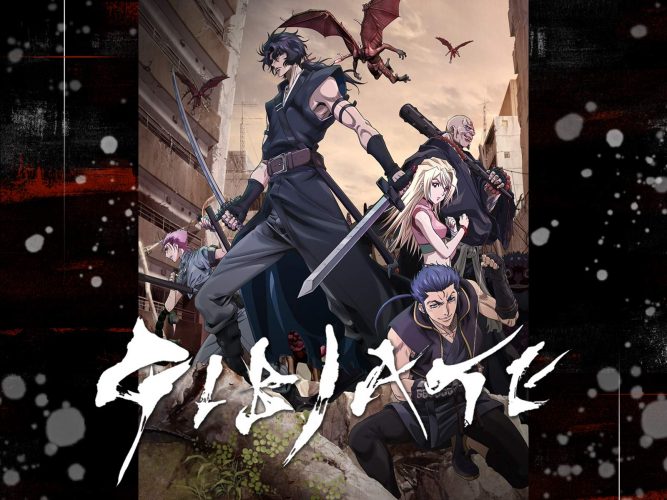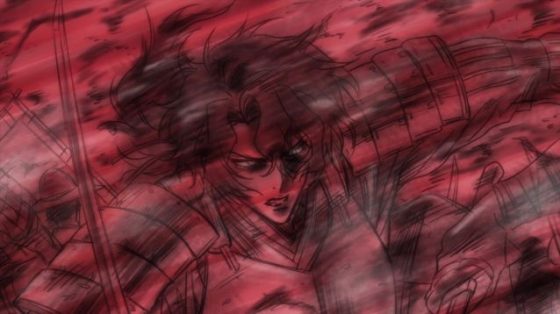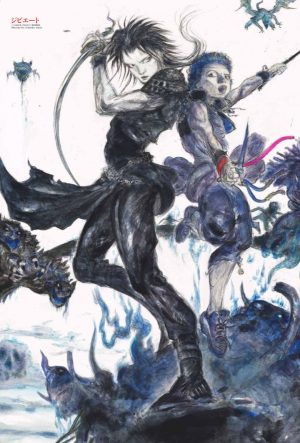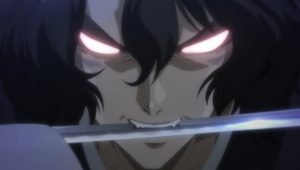
A new season means new anime and this time, we’re zooming in on the Summer 2020 anime, Gibiate. The series follows Sensui and Kenroku, two samurai from Edo Japan who are exiled from their respective communities for their own respective reasons but later find themselves transported to the 21st century, specifically to the year 2030. In 2028, the world succumbed to a deadly virus that turns people into giant monstrosities, supposedly based on their age, race, and sex. With less than five episodes out, what kind of impact is Gibiate having on this season? Here are our thoughts!
Three-Episode Test
A pilot episode is one of the most important for obvious reasons: the series needs to be impressive from the jump, or at least pose several questions that pique our interest. Gibiate gives us the exposé in the first episode: it introduces us to who we assume to be the protagonists; the samurai and attendant of a lord in feudal Japan named Sensui and a more free-spirited samurai named Kenroku. They are exiled from their respective clans for different reasons and find themselves on the same boat away from the mainland when they are rocked by a storm at sea. Suddenly, they’re in a ruined Tokyo landscape. In 2028, a pandemic broke out which effectively brought humanity to its knees. Those affected soon began transforming into giant monstrosities as the mysterious “Gibia Virus” wrought havoc on their DNA, morphing their bodies into the beasts. Long story short, Sensui and Kenraku come to realise that they’re in a dystopian future and they get by with the help of a young woman named Kathleen.
By the end of the first episode, things kick into gear fairly quickly as Sensui and Kenroku are brought back to a camp settlement where survivors reside. The art is the first thing that basically smolders with potential–the art style swings more towards a grittier feel, quite similar to Koutetsujou no Kabaneri (Kabaneri of the Iron Fortress) but perhaps not quite as good as far as animation goes. The compliments dwindle; however, when the “big bads” of the show so far, the Gibia, look quite out of place in contrast to the quite beautiful character and background art. Unfortunately, the texture of the Gibia makes for quite an uncomfortable experience as far as the visuals go, which is quite disappointing especially given how often we have to see them.
The series could do more with regards to the time-leap aspect, but it seems that after three episodes, Sensui and Kenroku seem to be more caught up with slashing at giant deformed humans than figuring out why they’re not in Edo. The time-leap applies when Sensui learns what became of his clan as well as the outcome of the unification of Japan. While the outcome does shake Sensui emotionally, we quickly skip over all of that because of the appearance of a mega Gibia that looks like a statue as well as a mysterious large man dressed in Wafuku and decorated in prayer beads, clearly in the same precarious temporal situation as Sensui and Kenroku.
Characters
The characters are introduced fairly quickly and we see what their basic stories are about in the first ten minutes of the series, so their personalities are hard-coded into the expository parts of the pilot episode. Kathleen is given a rather dramatic entrance when; assisted by an old man named Maeda, she saves Sensui and Kenroku from a Gibia and extracts some bodily fluid from the incapacitated beast. We can understand Sensui and Kenroku as an instance of “red ogre; blue ogre”, in which one is hot-headed, spunky, and passionate while the other exudes an air of regality, intelligence and a sense of rigid discipline. The series focuses a lot less on the fact that the two are out of their own time by several centuries, but by episode 3, Sensui is riddled with guilt and sorrow over the outcome of his leader and clan.
In the second and third episode, Kathleen creates video diaries of Sensui and Kenroku, allowing them to talk about themselves and explore a little bit about their lives prior to their spiriting away. In Kenroku’s diary, he explains why he was exiled from the Sanada Clan and even compares Kathleen to his lover, Okuni. The third episode is aptly named “The Third Man” as it introduces the monk Onikura Yukinojyo, another character who finds himself transported to a futuristic apocalypse.
What About the Plot?
Time-leaping, a world-ending virus, and the infected transforming into giant chimera-like monsters. Gibiate crams different aspects into its main plot; however, each of the individual plot devices could function very well on their own, but together they do more harm than good. Some in-story bugs—apologies for the pun—also sour the Gibiate experience, like when modern-day soldiers find themselves unable to perforate the Gibia with military-grade weaponry but a random centuries-old samurai cuts through them with a regular old katana with ease – it’s just confusing; how is cold steel winning against hot lead?
Another concerning minor plot and continuity hole is that of Kathleen’s mother, who has supposedly suffered from a broken mind as a result of the trauma that comes from being a) in a disease-addled apocalypse; and b) seeing giant human-eviscerating monsters emerge from the dead and the injured. Kathleen says that her mother can’t tell the difference between the Gibia and regular people as a consequence of her broken psychological state; however, Kathleen’s mother is the first to ask Maeda if he can hear the sound of dripping water – the supposed death knell symptom that presupposes someone being infected with the Gibia Virus. Perhaps many of these questions will be answered in future episodes, but right now, Gibiate leaves much to be desired.
Final Thoughts

Overall, Gibiate feels rather scattered and unsure of what it really aims to do as far as the plot is concerned, and the visuals that could’ve been a complete positive are marred by the jarring, 3D monsters that are the Gibia. The theme concerning a global apocalypse brought about by a virus is perhaps an influence of the situation humanity finds itself in in reality and from that angle, Gibiate can draw in a curious audience, but it can lose them just as quickly. What are your thoughts? Drop a comment below and let’s hear what you have to say!
Recommended Post
GIBIATE the Animation
Recommended Post



